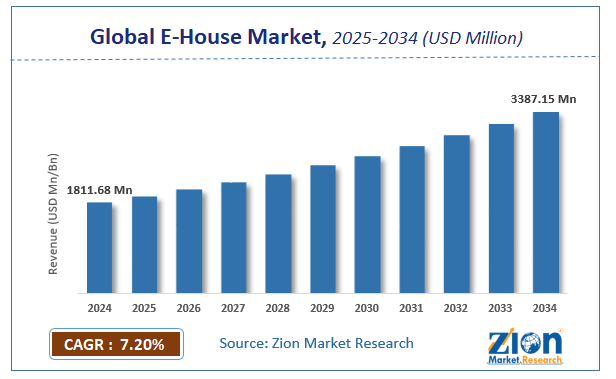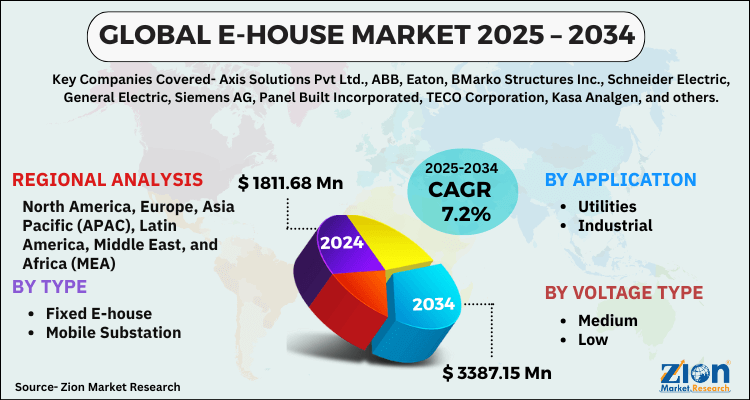E-House Market Size, Share, Growth & Trends 2034

E-House Market By Type (Fixed E-house and Mobile Substation), By Application (Utilities and Industrial), By Voltage Type (Medium and Low), and By Region - Global and Regional Industry Overview, Market Intelligence, Comprehensive Analysis, Historical Data, and Forecasts 2025 - 2034
| Market Size in 2024 | Market Forecast in 2034 | CAGR (in %) | Base Year |
|---|---|---|---|
| USD 1811.68 Million | USD 3387.15 Million | 7.2% | 2024 |
E-House Market: Industry Perspective
The global e-house market size was worth around USD 1811.68 Million in 2024 and is predicted to grow to around USD 3387.15 Million by 2034 with a compound annual growth rate (CAGR) of roughly 7.2% between 2025 and 2034. The report analyzes the global e-house market's drivers, restraints/challenges, and the effect they have on the demands during the projection period. In addition, the report explores emerging opportunities in the E-house industry.
E-House Market: Overview
A prefabricated mobile enclosure that contains various electrical and electronic elements such as medium- and low-voltage switchgears, digital electronic systems, transmission devices, and other auxiliary equipment is known as an electrical house (e-house). It is utilized in a variety of end-use industries, including chemicals, oil & gas, aerospace, locomotives, and metal manufacturing, for power supply and transmission. In both small and large-scale projects, it is frequently linked to major loads to considerably reduce energy expenditures and needed cable size.
E-House, also known as the powerhouse, is a walk-in outdoor enclosure. They are used in locations that are not easily accessible to the power supply. E-houses distribute power as per the requirements. They are an alternative to traditional power distribution solutions. E-houses can be skid (on-ground) or mobile (on-wheel).
Key Insights
- As per the analysis shared by our research analyst, the global e-house market is estimated to grow annually at a CAGR of around 7.2% over the forecast period (2025-2034).
- Regarding revenue, the global e-house market size was valued at around USD 1811.68 Million in 2024 and is projected to reach USD 3387.15 Million by 2034.
- The e-house market is projected to grow at a significant rate due to demand for modular electrical substations in industries such as mining, oil & gas, and power generation.
- Based on Type, the Fixed E-house segment is expected to lead the global market.
- On the basis of Application, the Utilities segment is growing at a high rate and will continue to dominate the global market.
- Based on the Voltage Type, the Medium segment is projected to swipe the largest market share.
- Based on region, Asia-Pacific is predicted to dominate the global market during the forecast period.
E-House Market: Growth Drivers
Acceptance of the replacement of SF6 for lesser environmental impact is driving the market
The global E-house market is being driven by the substitution of SF6 to reduce the environmental effect. SF6 (Sulfur Hexafluoride) has been used as a switching medium and insulation for electrical switchgear in e-house for decades due to its unique features. However, because SF6 is a greenhouse gas, it has life-cycle management expenses, which are increasing as the number of aged substations is decommissioned. As a fact, major provider of SF6 such as ABB has been researching alternatives with lower environmental effect, arc interruption, and insulating features similar to SF6 in recent years. This goal has already been completed, and in Switzerland, the world's first gas-insulated switchgear (GIS) pilot installation using a novel gas combination was recently commissioned. All these factors will contribute to the growth of the market over the forecast period.
E-House Market: Restraints
High set-up costs associated with the e-house may restrain the market growth
After design and manufacture of e-house, pre-assembly is required which includes construction & coating of steel frame, mechanical installation of equipment, and installation of floor, wall, & roof elements. In addition to this, prior to delivery to the project site, the E-House power equipment and auxiliary systems need thorough inspection and testing to ensure their high quality and operation. All these factors lead to high costs which in turn may hinder the market growth.
E-House Market: Opportunities
Increasing rate of digitalization in E-house sector is likely to offer better market growth opportunities.
The global E-house market is being driven by the digitization of e-house. The digital revolution is underway and has already made significant headway in the energy sector, presenting enormous prospects and advantages. From generation to customer relationship management, the influence of digitalization on electrical distribution is designed to enhance operations and increase flexibility throughout the power value chain. By minimizing switchgear footprint in the substation room and managing energy effectively for switchgear operation, installing digital switchgear already helps significantly to enhancing operating efficiency. For example, in medium-voltage switchgear with 30 panels at 11 kV, the width may be lowered by around 7 percent and the switchgear's energy consumption is reduced by about 300MWh throughout its lifespan. Governments and regulatory organizations are now encouraging better measurement systems and environmental standards for generation and consumption, as well as more effective resource usage. These initiatives help to drive demand for smarter distribution equipment like digital switchgear, which helps the market develop.
E-House Market: Challenges.
Low penetration of the market in the low and middle-income countries may serve as a major challenge for market growth
E-house is mostly dependent on internet connectivity which is found to be poor in under-developed countries. Low disposable income and poor infrastructure are also some of the factors that are responsible for the lack or poor internet connections in countries with low- and middle-income populations. All such factors pose challenges to the growth of the market.
E-House Market: Report Scope
| Report Attributes | Report Details |
|---|---|
| Report Name | E-House Market |
| Market Size in 2024 | USD 1811.68 Million |
| Market Forecast in 2034 | USD 3387.15 Million |
| Growth Rate | CAGR of 7.2% |
| Number of Pages | 156 |
| Key Companies Covered | Axis Solutions Pvt Ltd., ABB, Eaton, BMarko Structures Inc., Schneider Electric, General Electric, Siemens AG, Panel Built Incorporated, TECO Corporation, Kasa Analgen, and others. |
| Segments Covered | By Type, By Application, By Voltage Type, and By Region |
| Regions Covered | North America, Europe, Asia Pacific (APAC), Latin America, The Middle East and Africa (MEA) |
| Base Year | 2024 |
| Historical Year | 2020 to 2023 |
| Forecast Year | 2025 - 2034 |
| Customization Scope | Avail customized purchase options to meet your exact research needs. Request For Customization |
E-House Market: Segmentation
The global E-house market is divided based on type, application, voltage type, and region. Based on the type, the global market is split into fixed E-house and mobile substation. The application segment comprises utilities and industrial. By voltage type, the market is split into medium and low.
Recent Developments
- In February 2020, GE Power recently supplied an e-house and VSDS to Shell Nederland Chemie B.V.'s petrochemical facility. The VSDS from GE combines a high-speed induction motor and a varying drive to achieve a compressor train energy efficiency of over 90 percent.
- In May 2021, In Minas Gerais, WEG announced a collaboration with Vale for the manufacture of E-Houses. The two firms inked a contract for the delivery of solar E-Houses for the execution of the Sol do Cerrado Project, which is one of Brazil's largest photovoltaic power producing parks.
E-House Market: Regional Landscape
North America to lead the global market over the forecast period.
North America is expected to have a sizable share in the global E-house market during the forecast period. The market is expected to increase substantially due to the rising number of industrial units in oil & gas, mining, and other industries, as well as the presence of major companies like ABB Ltd, Siemens AG, and others. Canada is one of the world's top oil and gas producers. Its oil and gas sector is vital to the economy of the country. Oil sands, which account for over 90 percent of the country's total oil reserves, remain the country's principal source of hydrocarbon production. According to the Canadian Association of Petroleum Producers (CAPP), oil output in Canada is predicted to exceed 5.5 billion barrels per day (bbl/d) in 2030, with oil sands accounting for 70.7 percent of total production. On the other side, the Middle East and Africa are expected to have a healthy e-house market share. The increased demand for e-houses from the utility industry is accountable for this surge. Furthermore, the Middle East's rapidly expanding mining, as well as oil and gas sectors, is expected to boost the market growth.
E-House Market: Competitive Landscape
The global E-house market is fragmented due to the large number of organizations offering an e-house solution. Furthermore, with the existence of multiple worldwide and regional competitors are proposing novel solutions to conserve energy in industrial units while providing additional functions, resulting in a highly competitive market environment. Key players functioning in the market include:
- Axis Solutions Pvt Ltd.
- ABB
- Eaton
- BMarko Structures Inc.
- Schneider Electric
- General Electric
- Siemens AG
- Panel Built Incorporated
- TECO Corporation
- Kasa Analgen.
Global E-house market is segmented as follows:
By Type
- Fixed E-house
- Mobile Substation
By Application
- Utilities
- Industrial
- Oil & Gas
- Mining & Minerals
- Chemicals
- Other Industrial Applications
By Voltage Type
- Medium
- Low
By Region
- North America
- The U.S.
- Canada
- Europe
- France
- The UK
- Spain
- Germany
- Italy
- Rest of Europe
- Asia Pacific
- China
- Japan
- India
- South Korea
- Southeast Asia
- Rest of Asia Pacific
- Latin America
- Brazil
- Mexico
- Rest of Latin America
- Middle East & Africa
- GCC
- South Africa
- Rest of Middle East & Africa
Table Of Content
Methodology
FrequentlyAsked Questions
The global e-house market is expected to grow due to increasing adoption of modular electrical solutions in industries such as oil & gas, mining, and infrastructure, along with the need for cost-effective power distribution solutions.
According to a study, the global e-house market size was worth around USD 1811.68 Million in 2024 and is expected to reach USD 3387.15 Million by 2034.
The global e-house market is expected to grow at a CAGR of 7.2% during the forecast period.
Asia-Pacific is expected to dominate the e-house market over the forecast period.
Leading players in the global e-house market include Axis Solutions Pvt Ltd., ABB, Eaton, BMarko Structures Inc., Schneider Electric, General Electric, Siemens AG, Panel Built Incorporated, TECO Corporation, Kasa Analgen, among others.
The report explores crucial aspects of the e-house market, including a detailed discussion of existing growth factors and restraints, while also examining future growth opportunities and challenges that impact the market.
List of Contents
Industry PerspectiveOverviewKey InsightsGrowth DriversAcceptance of the replacement of SF6 for lesser environmental impact is driving the marketRestraintsHigh set-up costs associated with the e-house may restrain the market growthOpportunitiesIncreasing rate of digitalization in E-house sector is likely to offer better market growth opportunities.Challenges.Low penetration of the market in the low and middle-income countries may serve as a major challenge for market growthReport Scope Recent DevelopmentsRegional LandscapeNorth America to lead the global market over the forecast period.Competitive LandscapeGlobal E-house market is segmented as follows:By TypeBy ApplicationBy Voltage TypeBy RegionRelatedNews
HappyClients
Zion Market Research
Tel: +1 (302) 444-0166
USA/Canada Toll Free No.+1 (855) 465-4651
3rd Floor,
Mrunal Paradise, Opp Maharaja Hotel,
Pimple Gurav, Pune 411061,
Maharashtra, India
Phone No +91 7768 006 007, +91 7768 006 008
US OFFICE NO +1 (302) 444-0166
US/CAN TOLL FREE +1 (855) 465-4651
Email: sales@zionmarketresearch.com
We have secured system to process your transaction.
Our support available to help you 24 hours a day, five days a week.
Monday - Friday: 9AM - 6PM
Saturday - Sunday: Closed






